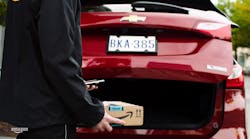Amazon has been talking about package delivery to a vehicle trunk as a potential alternative to a home doorstep for years — the key was how it would work. Now, with some app-based permissions and remote, outside-originated vehicle unlocking capability, a package can be delivered inside your General Motors vehicle.
That might be for convenience, but it's likely also more secure in many cases than leaving a package delivered at home while the recipient is away. GM and Amazon announced this last-mile option called Key In-Car Delivery for owners of 2015 and newer Chevrolet, GMC, Buick and Cadillac vehicles with an active OnStar account and Amazon Prime. It went live in 37 cities and surrounding areas on Tuesday.
This extends an existing Onstar capability. With the authorized user's permission, GM's OnStar service has long been able to unlock a vehicle's doors remotely; that's part of OnStar's "what if" safety and emergency services sell.
Amazon Key In-Car gives the Amazon deliveryman access to this function, adding more addresses where packages can be delivered. Users can enter locations where their car is kept such as a parking lot at work or other publicly accessible place.
Note that the service doesn't have to use a different location than someone's typical package delivery address — it's allowing outside access to their vehicle. A user could authorize their home or apartment address so a package could be delivered into their car parked on the street or in a driveway there instead of being left on the doorstep.
"Prime members now have another way to ensure their packages are safe and secure — all for no additional cost," said Peter Larsen, vice president of delivery technology at Amazon. The trunk delivery service will work with same-day, two-day and standard shipping, according to the company.
GM noted that the new service will be available for some 7 million vehicles, so presumably this won't only work with a trunk — it'll also work for leaving packages, e.g., in a pickup truck's cab, since many GM 2015 and newer vehicles on the road today are Chevrolet Silverados and Colorados or GMC Sierras and Canyons.
In any event, it will require an app that has significant access to personal information and now property as well. Users download the Amazon Key app and link it to their OnStar and Amazon accounts and use it to enter their authorized addresses. The app notifies a user when a package is on the way and when it's been delivered and the vehicle is relocked.
With better package security being one of the main benefits touted of the service, a critical point of this service will be, effectively, whether customers can trust Amazon with the keys — and that's in terms of cybersecurity, trustworthiness of personnel, and system malfunctions. OnStar itself has faced similar questions in the past.
In a related vein, Amazon also sells a "smart lock" system called Amazon Key In-Home that can be operated remotely and pairs up with a cloud-connected video camera to monitor its use. That was announced last fall.
The idea is similar: it allows users to remotely unlock their doors to let people or services in, and packages can be delivered inside the home rather than left outside, where they could be stolen. The selling points, once again, are convenience and added security — but the system isn't flawless and has experienced glitches in use.




